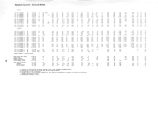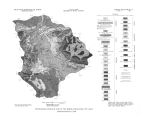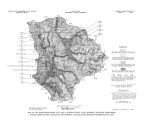| OCR Text |
Show Valley, but part of this material is undoubtedly volcanic rocks of Tertiary age rather than unconsolidated alluvial fill. The presence of volcanic rocks and conglomerates of Tertiary age and low density under most of Parleys Park makes it impossible to estimate the thickness of the unconsolidated material by geophysical techniques, but available data suggest a maximum thickness of about 100 feet. Sparse data from well drillers' reports indicate that the alluvial fill in Round Valley is probably only a few tens of feet thick. The aquifer characteristics of the unconsolidated material in the four valleys are generally similar. The transmissivity ranges from 6,700 to 20,000 ft3/ d/ ft ( cubic feet per day per foot) in Heber Valley and probably is less in the other valleys. The specific yield is estimated to be 12- 15 percent. In Heber Valley the average annual recharge and discharge is calculated as about 86,000 acre- feet of water. The average annual recharge and discharge in Rhodes Valley is less- about 22,000 acre- feet. Available data for Parleys Park and Round Valley are too scanty to permit calculations of the volume of annual recharge and discharge. The calculated average evapotranspiration is 43,000 acre- feet per year in Parleys Park and 5,000 acre- feet in Round Valley. An estimated 280,000 acre- feet of water could be recovered by dewatering the upper 100 feet of the aquifer in the unconsolidated deposits in Heber Valley, 310,000 acre- feet could be recovered by dewatering the upper 100 feet in Rhodes Valley, and about 80,000 acre- feet could be recovered by dewatering the unconsolidated deposits in Parleys Park. The ground water in the alluvial fill of the valleys interchanges continuously with water in the streams, however, and none of the aquifers can be dewatered for consumptive use without ultimately reducing streamflow from the area. The water throughout the area, both surface water and ground water, is generally of good quality, and, with few exceptions, usable for domestic use, livestock, and irrigation. Most of the water is of the calcium bicarbonate type, but calcium sulfate water is present locally in and near shales of Triassic age. Near Midway, in Heber Valley, a group of thermal springs yield water that is too highly mineralized to be desirable for domestic use ( although it is suitable for livestock and for irrigation), and locally volcanic rocks of Tertiary age yield water that is too high in iron for many uses. 2 |
































































































